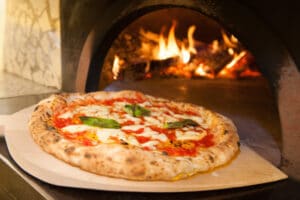Everyone from young to old enjoys a good pizza! The fact that pizza is so popular is so widely accepted that it is almost redundant to even say it.
As kids, it was the biggest treat our school could give us! They even encouraged reading by rewarding us with pizza, based on how many books we read!
Now, as adults, it is the easiest dinner we can think of!
Pizza is so popular that Americans eat approximately 3 billion pizzas per year! This works us out to 350 slices per second. If you do the math on 8 slices per pizza…well, that’s 13, 125 pizzas in the five minutes it takes you to read this article!
Even more interesting is that 17% of all restaurants in America are pizzerias! Additionally, 13% of Americans will eat pizza today!
Best of all, the varieties of pizza are endless! Okay, not endless. There are said to be over 34 million pizza combinations.
But, what makes a delicious pizza?
What is a Pizza?
This is an ardently debated topic. Quite simply, pizza is an Italian dish. It is a round dough with various toppings. The basic concept would include flatbread, sauce, cheese, and toppings which are then baked in an oven.
As typical in America, though, we could never leave well enough alone! Americans have redefined what Neapolitans would see as a pizza and are continuously stretching the boundaries in terms of flavor and creativity.
Much in the same way that nothing is more American than a burger, the U.S. has made pizza a staple food item! It has become unanimous that pizza and beer complement a Friday night football game the way Sonny Complements Cher!
As I like to call them, food snobs will argue that much of what we deem a pizza today is good, but not truly pizza. I argue that there is no bad pizza. All pizza is good pizza!
Pizza Origins
Like any good food, there is a history to be recognized.
It is said that pizza originates in Italy, Naples, to be exact. It is claimed that bakers made flatbreads to test the temperatures of their ovens. The flatbreads were sold to the poor of the community so that it was not wasted.
In the 16th century, the people of Naples began adding tomatoes to the dough. At the time, it was extremely forward-thinking.
Later, Raffaele Esposito created three types of pizza for the King and his wife, Queen Margherita. It is claimed that her favorite was the simple base with mozzarella, tomato, and basil representing the Italian flag.
The story claims this is the origin of the name of the Margarita pizza.
Today, The True Neapolitan Pizza Association exists as a non-profit that’s aim is to guarantee the authority of pizza to the City of Naples. Neapolitan pizza was officially registered as a Traditional Speciality Guaranteed dish in 2009, and in 2017, pizza twirling in Naples was added to Unesco’s “intangible heritage” list, a list including more than 350 art forms.
What is a pizza? Well, in Naples, it’s an art!
Pizza the American Way
American-Italian fusion has become the bedrock for pizza as we know it.
Americans took what was a classic and made it….better. The most common difference between the American version and the Naples classic is that vegetable oil or shortening is often added to the American-style dough.
America also features many different bases, including thin, thick, and the Chicago deep-dish.
Lombardi’s in Manhattan, New York, is recognized as the first pizzeria in the United States, having opened in 1906. Pizza then gained substantial popularity after World War II among soldiers returning from Italy.
While most of Italy will vow to keep the pizza simple, Americans pride themselves on the endless creativity found in ingredient combinations. Whether we are substituting a traditional tomato base with garlic butter or adding truffles and foie gras, we are definitely stretching the boundaries.
Diversity Among the Masses
Pizza has become a melting pot of diversity in flavor and style. Food fusion has made its mark.
You can find a pizza for every culture and meal. Breakfast pizza no longer refers to the cold leftovers of yesterday. These pizzas are typically cut into squares and feature the best of eggs, bacon, and cheese!
If you want something a little more south of the border, try a Mexican pizza. These ideally have seasoned beef or chicken, melted cheese, enchilada sauce, and plenty of sour cream! You can even spice yours up a bit with chiles.
Try swapping that tomato base for wasabi and building a sushi pizza! A typical sushi pizza will feature sushi-grade salmon or tuna, avocado, and seaweed. All of your sushi favorites in a pizza triangle!
The reality is that food fusion creates endless possibilities and new horizons in the world of pizza!
How to Make a Pizza
The variations in pizza making are as many as the flavor combinations! From rolling the dough with a wine bottle to cooking pizza on a campfire, pizza makers are unstoppable!
YouTube is bombarded with how-to videos showing you just about every trick of the trade. Yet, pizza making can be broken down into simple steps.
1. Make the Dough
This is the make or break point for most pizzas. Traditional Neapolitan pizza will feature a thin-crust, yeast-based dough.
Other culinary ventures feature a sourdough base, a thick base, and even a deep-dish pizza. Decide your favorite and perfect your dough.
2. Add Your Toppings
From the simple tomato base and mozzarella to goat cheese and truffles, the toppings list is endless.
Add your base, your cheese, your toppings, and don’t skimp!
3. Bake
Lastly and most importantly, bake your pie!
Yet, for the sake of posterity, let’s break this down into a little bit more detail.
The Crust Defines Us
The crust is probably the most defining point of a pizza. The different styles of pizza we encounter are largely based on the crust.
Imagine for a moment that a pizza is a house. The base provides the flavor structure or the physical house, if you will. The cheese would be the interior style while the toppings the decor.
Well, in this analogy, the crust is the foundation. Even the best house will crumble if the foundation is not the best.
So, what makes a good or great crust? It’s very simple. Taste, texture, and integrity.
Different types of pizza require different crusts. Ultimately, the crust’s integrity is its ability to do its job. A thin crust used in a Neapolitan pizza will not suffice for the number of toppings in a Chicago deep-dish.
The taste is also essential. A crust that is too empowered with yeast will produce a sour taste and create a pizza that is not that appetizing. However, different doughs create different tastes.
The texture also plays a part in the overall result. Certain doughs create a pizza that folds and rolls easily, while others produce a finished product that is crunchy.
Popular Crusts
Let us look at a few of the most popular crusts:
1. Neapolitan
This crust is best known for its “floppiness.” This is the original pizza crust and made famous in the pizzerias of Naples.
The Neapolitan crust is thin and maneuverable.
2. Chicago Deep-Dish
The crust’s origin is in its namesake. The specialty in this crust is the ability to soak in the fats and flavors of the toppings to ensure the crust does not burn.
Rather the long baking time (sometimes up to 45 minutes) creates a uniquely original flavor.
3. New York Style
While this crust can be compared to a Neapolitan, it finds its character in the ingredient attributes. By adding oil and sugar, a slightly thicker crust is given a beautiful brown while baked at lower temperatures.
The New York-style crust has given pizza the famous “fold” style of eating!
4. Focaccia
Focaccia is a less known crust but deserves its place among the greats. In fact, the focaccia-style crust can be seen as the true original pizza since flatbreads were the beginning idea for the pizza.
Focaccia crust is a more firm, crunchy crust leaving behind an almost breadstick-like crust on the outside of the pizza toppings.
5. Stuffed-crust
Among a more recent development in the world of pizza crusts, the stuffed crust has created a following of its own.
Most recognizable by the cheese-filled outer-rim, the stuffed crust provides a duo of tastes anyone can enjoy.
6. New Haven Style
The New Haven-style is by far the thinnest crust. This crust is usually odd in shape and quite crunchy, giving it strangely strong integrity for a thin base.
Spread thin and baked quickly at high temperatures, this crust is original in all aspects.
7. Other Styles
Crusts continue to adapt and are very much like the toppings that grace them. In the health-driven aspects, gluten-free and vegan crusts have become quite trendy.
Whether you prefer a thin crust or a thick crust, there is a pizza crust ideal for you!
The Perfect Temperature

Wood Burning Oven
This is the traditional and classic way to make a pizza. Reaching temperatures between 700-1000 Fahrenheit, these ovens never fail to give a rustic crust.
The biggest deciding factor in this oven is the flavor difference the different types of wood will provide.
Conveyor Ovens
These types of ovens are dominating the franchise pizza scene. Top of the class in efficiency and standard, these ovens create a streamlined system that makes it possible to produce hundreds of pizzas a day.
By using either gas or electricity, conveyor ovens produce an even temperature throughout the oven. Authenticity is pushed aside at the expense of availability and price to produce a single product over and over again.
Pizza Deck Ovens
These ovens are ideal for those who want the flavor of a wood-burning oven without the availability of space.
Shelves made of stone create a unique atmosphere that allows for gas or electricity to be used in reaching the desired temperatures. These ovens provide more authenticity to your product without the need for a large surface area.
Convection Ovens
These ovens are ideal in almost any circumstance. The convection oven maintains a temperature using much less electricity by circulating air through the oven.
These ovens produce consistent results while providing a rapid cook time.
Topping It All Off
While the crust creates the perfect foundation for a pizza, the toppings are essentially the jewels. Without the toppings, you are eating plain, baked dough.
64% of Americans say they prefer pepperoni to any other pizza topping. Other favorites include sausage, extra cheese, and mushrooms.
The toppings on a pizza can create quite the divide, from those who can’t imagine a pizza without onion to those who like a little bit more exotic flavor.
Cheese
This is essential in a delicious pizza. Most will agree it is the one ingredient that cannot be left out. Simple flavors to the intense with every variant in between, there is a cheese for every pizza.
The ultimate favorite is, of course, mozzarella. It is the most well-known cheese for pizza and creates a perfect melt. Adding cheddar can create a duo of flavors. The sharpness found in cheddar will complement both mild and spicy toppings.
Parmesan is another favorite and is said to belong on all pizzas. While it can be a little lacking on its own, its flavor pairs amazingly well with mozzarella.
Other cheeses that are finding their way to pizzas include aged Havarti, gorgonzola, and provolone.
Traditional Toppings
Most Americans prefer the traditional flavors found in pepperoni. The sharpness of the meat complements the mild flavor in mozzarella extremely well.
Your basic tomato base, which comes in many variants and a little garlic, can go a long way to creating a delicious pizza. There is a wide variety of toppings that can be classified as traditional when it comes to American pizza.
On the lighter side of things, mushrooms, onions, bell peppers, and olives are among the most popular vegetable toppings for a pizza.
For meat lovers, sausage, ground beef, and chicken tend to rank directly below pepperoni.
Out of the Box Toppings
Yet, with anything good, we desire to make it great. Culinary experts have brought the best of the best to the world of pizza, making it a meal that is worthy of gracing tables among the Michelin stars.
Black truffles and foie gras have found their way to pizzas across the nation. The freshest ingredients from the ultimate sources create an experience vastly different from the fast-food delivery we are used to.
Debating the use of grain-fed to grass-fed beef will only lead you to question whether to use ground beef or steak strips. However, the variations go deeper.
Eggplant and artichoke hearts are finding new ground on pizzas, while smoked salmon and seaweed create a unique experience. Other variations, including sun-dried tomatoes, chorizo, caviar, crocodile, and even reindeer, are making an impact.
Before You Go
Ideally, there is a pizza for everyone. New York alone is home to close to 7,000 pizzerias. From fast-food chains to 5-star gourmet tables, pizza is about as American as an apple pie. And we will keep evolving it as our taste buds desire.
Whether you prefer a crust that you can roll or pizza in tiny squares, you can build, bake, and cut to your liking! Naples may have started the pizza, but America made it what it is today. Still, there is one topic I dare not broach….does pineapple belong on a pizza?
The possibilities are amazing, and pizza is bridging the generational gap. So, what is your favorite slice?




